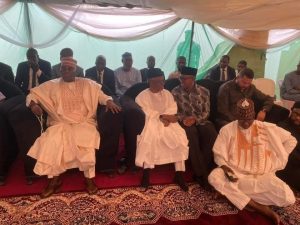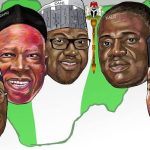Daura, Katsina State – July 16, 2025
Labour Party presidential candidate Peter Obi paid a condolence visit to the family of former President Muhammadu Buhari, one day after the latter’s state burial in Daura, Katsina State. The visit came amid rising online and media backlash accusing Obi of intentionally snubbing the North during the burial ceremony.
Obi joined other political figures at the Fidda’u prayer session, including former Vice President Atiku Abubakar and former Kaduna State Governor Nasir El-Rufai. He was received by Mamman Daura, a close relative of the late president, at the Buhari family compound.
Photographs published by Punch Newspapers confirmed Obi’s presence in full traditional attire, seated solemnly among Muslim elders and dignitaries — a visual counter to earlier accusations of disrespect.
—
Context: The Absence, the Visit, and the Storm
President Buhari died on July 13, 2025, in a London hospital, and was buried on July 15 with full Islamic rites, military honors, and the presence of Nigeria’s current president Bola Ahmed Tinubu. However, Peter Obi’s absence at the burial was seized upon by several Northern political commentators as a betrayal of cultural respect.
Among the loudest voices:
Reno Omokri, ex-presidential aide, tweeted: “Arewa, remember who was not there!”
Sarki, a Northern youth leader, warned: “Let’s see how he plans to become president without our votes.”
Comedian Deeone went further with mocking commentary, reducing Obi’s absence to “no rice to share”.
In response, Obi issued a written condolence message via social media on July 15, describing Buhari’s legacy as “dignified” and praying for his eternal rest in Aljannatul Firdaus.
By July 16, Obi made the physical visit — a swift move interpreted by many as damage control.
—
吝 Igbo Leadership and the Burden of Optics
The swift escalation of criticisms points to a deeper reality: in Nigerian politics, symbolic presence often outweighs policy ideas. For Igbo leaders, this symbolism is a tightrope. The North wields political influence disproportionate to voter equity, and any misstep is amplified through ethnic lenses.
Yet, it is worth noting:
Obi’s visit did happen less than 24 hours after the burial.
Photographic and media evidence confirms his engagement in local condolence rites.
Other leaders, such as Atiku and El-Rufai, were present at the same time.
The absence of world leaders at Buhari’s burial suggests that the event — while significant locally — was not globally prioritized.
Still, the criticism was almost exclusively focused on Peter Obi — raising legitimate questions about ethnic double standards in public expectations and media narratives.
—
For the Archives: Key Timeline of Events
Date and Event
July 13, 2025 Buhari dies in London hospital
July 15, 2025 State burial in Daura (Obi absent)
July 16, 2025 Obi attends Fidda’u prayer with dignitaries
—
What This Means for 2027 – And For Ndi Igbo
The 2027 presidential race is already heating up. The reactions to this event show how much emotional capital is tied to public performances in Nigeria. For Peter Obi, who remains a symbol of hope for many young Nigerians — especially across Southern Nigeria — maintaining national appeal requires navigating tribal landmines without losing authenticity.
But this episode also reinforces a pattern: Igbo candidates are held to stricter emotional and cultural expectations, often by those who downplay or deny Igbo grievances in national discourse.
Thus, for documentation and historical record:
Obi was criticized not for policy failure, but for perceived absence at a burial.
He responded swiftly with both written and physical condolence.
Despite proof of presence, the narrative of “absence” was amplified for political mileage.
—
茶 Conclusion: Symbolism, Strategy, and the Need for Narrative Ownership
Peter Obi’s visit to Daura was not just a condolence gesture — it became a test of political survival in optics-driven Nigeria. It highlights how media narratives can distort facts unless meticulously documented.
For Ndi Igbo, this serves as a cautionary case study: presence must not only be enacted but recorded, published, and archived — because absence will be assumed, and motives twisted, if not corrected with evidence.
This incident joins a long line of politically weaponized narratives, where silence, delay, or misinterpretation becomes ammunition. That is why we document. That is why we archive.







